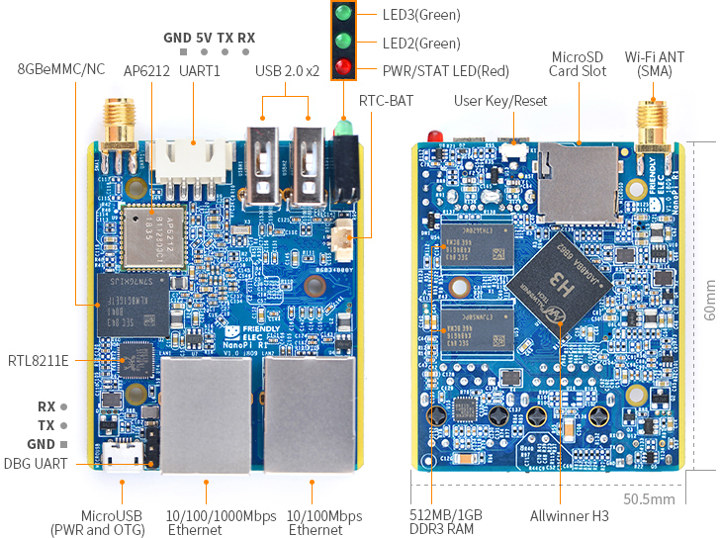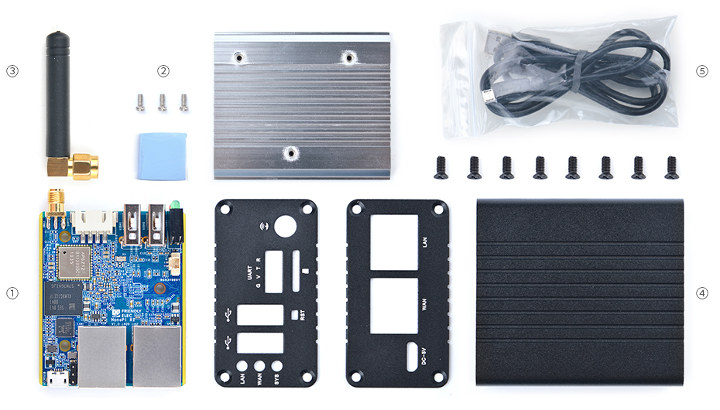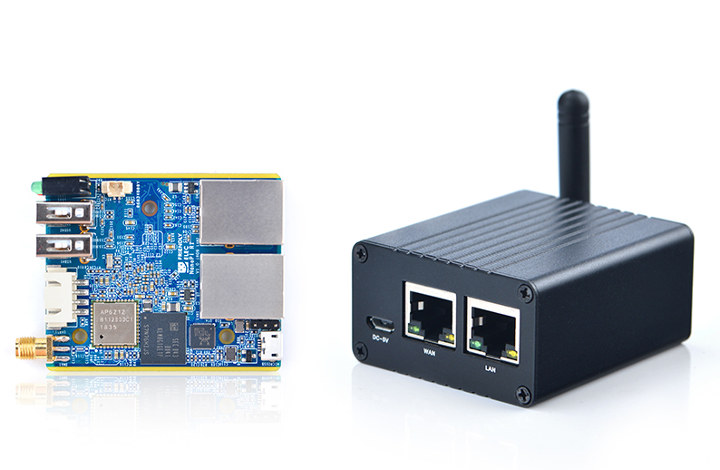A couple of years ago, Shenzhen Xunlong Software launched Orange Pi R1 board powered by Allwinner H2+ processor with two Fast Ethernet ports, and some I/Os which could be useful for intelligent controllers and simple IoT gateways. FriendlyElec has now launched a similar, but improved product with their NanoPi R1 featuring Allwinner H3 processor coupled with 512MB or 1GB memory, two Ethernet ports, WiFi and Bluetooth connectivity, packaged in a neat metal case.
- SoC – Allwinner H3 quad-core Arm Cortex-A7 processor @ up to 1.2GHz with Mali-400MP2 GPU
- System Memory – 512MB or 1GB DDR3 RAM
- Storage – MicroSD Slot, optional 8GB eMMC flash
- Connectivity
- 1x Gigabit Ethernet, 1x Fast Ethernet
- 802.11b/g/n WiFi 4 with SMA antenna interface
- Bluetooth 4.0 dual mode (Classic / LE)
- USB – 2x USB Type-A host ports, 1x micro USB OTG port
- Debugging – 3-pin 2.54mm pitch header for serial console
- Serial – 4-pin 2.54mm pitch UART header (compatible with Seeed Studio Grove modules?)
- Misc – 3x LEDs, 1x user key/reset button
- Power Supply – DC 5V/2A via micro USB port
- Dimensions – 60 x 50.5mm
- Temperature Range – -40 to 80
 The company provides U-boot 2017-11, Linux 4.14, Ubuntu-Core 16.04, and OpenWrt for NanoPi R1 gateway, and you’ll find links and resources to get started in the Wiki.
The company provides U-boot 2017-11, Linux 4.14, Ubuntu-Core 16.04, and OpenWrt for NanoPi R1 gateway, and you’ll find links and resources to get started in the Wiki.
Two versions of the gateway are available: one with 512MB RAM and no internal storage (boots from micro SD card), and the other with 1GB RAM, and 8GB eMMC flash selling for respectively $29 and $39 on FriendlyElec store as part of a kit with a custom metal case, a heatsink with paste and screws, one antenna, and a micro USB cable.
 Thanks to theguyuk for the tip.
Thanks to theguyuk for the tip.

Jean-Luc started CNX Software in 2010 as a part-time endeavor, before quitting his job as a software engineering manager, and starting to write daily news, and reviews full time later in 2011.
Support CNX Software! Donate via cryptocurrencies, become a Patron on Patreon, or purchase goods on Amazon or Aliexpress






If that gets armbian support it would be nice.
If this R1 would rely on H5 instead it would be 99.99% compatible to their NanoPi NEO Core2 (different leds and useless 1T1R 2.4GHz WiFi). Though the task is rather simple since all that’s needed is adjusting a few DT bits. But FriendlyELEC still uses 4.14LTS while Armbian moved on to 4.19 in the meantime so maybe some adjustments are needed: https://github.com/friendlyarm/linux/blob/sunxi-4.14.y/arch/arm/boot/dts/sun8i-h3-nanopi-r1.dts
That’s great, because I’m porting your armbian patches to another open source Yocto meta layer to support those allwiner boards. And that board is quite interesting for custom Linux builds.
Good they listened to community and improved heat dissipation to the bottom (which can be turned ‘top’ by flipping the whole thing by 180°).
But I don’t get the SoC choice. Why not H5 instead since ARMv8 Crypto Extensions or not can make a difference with VPN use cases?
BTW: people might ask: the 100 Mbit/sec Ethernet is not H3’s internal Fast Ethernet MAC/PHY but an USB2 attached RTL8152B just like on Orange Pi R1.
Maybe they get a volume discount on H3 or is Openwrt more mature on H3 ?
Project Adiantum could possibly be included as patches in kernel 4.9/4.14/4.19 to assist AES encryption performance ?
https://android-review.googlesource.com/q/topic:%2522adiantum-4.9%2522++OR++topic:%2522adiantum-4.14%2522+OR+topic:%2522adiantum-4.19%2522
I understood Adiantum targeting internal filesystem encryption on Android devices. Is there any VPN solution now that could make use of it?
It certainly worth further discussion since its focus is on AES and Poly1305 acceleration, while filesystem encryption is only one use.
No. Adiantum is a replacement for pure AES encryption of data at rest when AES acceleration is not available. Given the blcoksizes Adiantum operates on, I do not think it is suitable for VPN.
H5 already EoL
@Coldfish I didn’t know that. Source?
> H5 already EoL
Would make some sense since IIRC there was never a TV box using H5. And H5 has been replaced on Allwinner’s website with old and boring H8 (AKA A83T) now relabeled as H80 between March and Dec 2018: https://web.archive.org/web/20180303050105/http://www.allwinnertech.com/index.php?c=product&a=index&pid=6 vs. https://web.archive.org/web/20181217194344/http://www.allwinnertech.com/index.php?c=product&a=index&pid=6
Since there are plenty of Openwrt Routers and Router boards on Aliexpress at less thn $40, what is the advantage or reason for these H2, H3 router boards?
@theguyuk most other cheap OpenWRT routers currently are single/dual core only while H2/H3 are quad core
basically as any other h3/h5 board. you have 2 usb ports so you can turn it into personal cloud/nas/home server, or add usb gsm/lte modem and go far and beyond. and h3/h5 mainline support is sweet. thanks linux-sunxi!
If this had native dual gigabit ports, then it would be interesting.
100M in 2019 ? Yeah, no thank you sir.
> If this had native dual gigabit ports, then it would be interesting
With which use case in mind? I mean if this should be used as a firewall then which throughput expectations do you have with packet filtering enabled? As a reference: https://www.netgate.com/blog/netgates-new-sg-1100-punches-way-above-its-weight.html
I would expect this being a router/firewall thingy for 100 Mbps uplink connections. The one GbE port (strangely labeled WAN) being there to be used as LAN port and combined with a VLAN capable GbE switch allowing for fine grained port restrictions.
Every decent ISP has 100Mbit+ connections nowadays (i have 150M on coax) so using this a gateway/router/firewall would actually bottleneck my connection.
So if you have slow internet (like 10-20Mbit) you can get away with a cheap openwrt compatabile router. Will be cheaper and more useful.
Also, since this board is usb based, you can do that yourself (like with a orange pi zero and a cheap usb nic) for half the money and better compatability.
So this board in my eyes would only make sense (for the same price) if it had dual gigabit and perhaps openwrt support out of the box. You can’t do that yourself cheaply.
> using this a gateway/router/firewall would actually bottleneck my connection
But most probably not due to one port being 100 Mbps but lack of processing power in general? The ARM or MIPS SoCs usually used in those cheap OpenWRT boxes do HW NAT but as soon as they should really run all the packets through a filter usually everything gets slow as hell (talking about both bandwidth and latency). Not sure how H3 would perform here…
Anyway, I don’t understand the purpose of this product. The wiki page talks about ‘secondary router’ so maybe this is something you put in your bag to use it in a hotel room to share the hotel’s (cable) Internet with your wireless devices? Don’t know…
With newer openwrt builds, you have flow offloading which improves nat performance quite a bit, so even cheaper single core routers are able to cope with fast internet connections.
There’s always RPi with a gigabit LAN. Just plug in USB3 Realtek dongles to get more ports.
… and there’s always Jerry speaking from Uranus
It makes no sense to buy this instead of the Orange Pi R1 – I don’t think you could even get gigabit performance with a VPN on it anyway
If you exchange roles of LAN and WAN port then the GbE port in combination with a VLAN capable GbE switch could at least make some sense (though no VPN and no sophisticated packet filtering).
BTW: H5 EoL confirmed.
With openvpn certainly not, but wireguard would be an option. Also with a USB3-gigabit adapter you could maybe get another ethernet port with speed between 100 and 1000 mbps.
Or maybe even a ZeroTier bridge
> with a USB3-gigabit adapter you could maybe get another ethernet port with speed between 100 and 1000 mbps
If they would’ve replaced the RTL8152B with an RTL8153 (best USB3-GbE adapter I know) the USB2 connected Ethernet port would be good for 300-350 Mbps. No idea about BoM costs though…
Well if you buy this and the adapter you end up with 3x the price of OPi R1 so it makes no sense